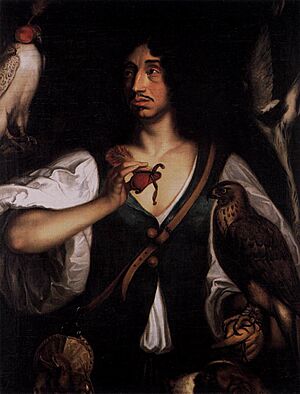Frederick, Landgrave of Hesse-Eschwege facts for kids
Quick facts for kids Frederick, Landgrave of Hesse-Eschwege |
|
|---|---|
 |
|
| Spouse(s) | Countess Palatine Eleonora Catherine of Zweibrücken |
| Issue | |
| Christine, Duchess of Brunswick-Wolfenbüttel-Bevern Juliana, Baroness of Lilienburg Charlotte, Countess of Bentheim-Tecklenburg |
|
| Noble family | House of Hesse |
| Father | Maurice, Landgrave of Hesse-Kassel |
| Mother | Juliane of Nassau-Siegen |
| Born | 9 May 1617 Kassel |
| Died | 24 September 1655 (aged 38) Costian, near Poznań |
| Burial | Market Church in Eschwege |
Frederick of Hesse-Eschwege was a German prince who lived from 1617 to 1655. From 1632 until his death, he was the Landgrave of Hesse-Eschwege. A Landgrave was a type of ruler, like a duke or count, in parts of Germany. Hesse-Eschwege was a smaller territory that was part of a larger one called Hesse-Kassel. Think of it like a smaller state within a bigger country.
Contents
Early Life and Family
Frederick was born in Kassel on May 9, 1617. He was the eighth child of Landgrave Maurice of Hesse-Kassel. His father, Maurice, had to give up his rule because of money problems.
Before this, Maurice decided to divide a part of his land, called the Rotenburg Quarter, among his sons. This was suggested by his second wife, Juliane of Nassau-Siegen. Frederick received the area around Eschwege. His brothers, Herman IV and Ernest, received other parts of this land.
Frederick's father, Maurice, lived in Eschwege with his second family until he passed away in 1632. After his death, Maurice's widow and children moved to Rotenburg Castle.
Life as a Landgrave
The town and castle of Eschwege were badly damaged during the Thirty Years' War in 1637. Because of this, Frederick, who was 20 years old at the time, probably didn't move into his home in Eschwege until 1646. This was after he got married in Stockholm.
Frederick had a successful career in the Swedish army, where he became a Major General. It's not fully known if he fought in the Thirty Years' War. However, he did lead a Swedish army group during the Second Northern War.
Because of his military duties, Frederick spent a lot of time at the Swedish court. He didn't visit Eschwege very often. His three brothers helped rule his part of the Rotenburg Quarter for him. Even so, he cared about the people living in his land. He helped a lot with rebuilding the area after the Thirty Years' War ended. His wife mostly stayed in Eschwege, and their children were born there.
Death and What Happened Next
Frederick passed away on September 24, 1655, in Costian, near Poznań, Poland. He died while serving in the army of his brother-in-law, King Charles X Gustav of Sweden, during the Second Northern War.
His body was buried in the Market Church in Eschwege. It took two years for his coffin to arrive there. After Frederick's death, his land, Hesse-Eschwege, went to his brother, Ernest of Hesse-Rheinfels.
Frederick's wife was given the castle in Eschwege to live in. However, she chose to move to her own land in Osterholz, near Bremen, Sweden. She died in 1692 and was also buried in the royal crypt in the Market Church in Eschwege. In 1667, the castle in Eschwege was used as a guarantee for a loan. This loan was taken out to provide a dowry for his daughter, Christina.
Frederick's Full Title
Frederick's full title, as written on his coffin, was: Frederick, the brave hero, Landgrave of Hesse, Prince of Hersfeld, Count of Katzenelnbogen, Diez, Ziegenhain, Nidda and Schaumburg.
Marriage and Children
Frederick married Eleonora Catherine on September 8, 1646, in Stockholm. Eleonora Catherine (1626-1692) was the daughter of Count Palatine John Casimir of Kleeburg. She was also the sister of the Swedish king Charles X Gustav.
Frederick and Eleonora Catherine had the following children:
- Margarete (born March 31, 1647, in Erfurt – died October 19, 1647, in Erfurt).
- Christine (born October 30, 1648, in Kassel – died March 18, 1702, in Bevern). She married Ferdinand Albert I, Duke of Brunswick-Lüneburg-Bevern in 1667.
- Elisabeth (born April 7, 1650, in Eschwege – died April 27, 1651, in Eschwege).
- Juliana (born May 14, 1652, in Eschwege – died June 20, 1693, in IJsselstein). She married Johann Jakob Marchand, Baron of Lilienburg, in 1680.
- Charlotte (born September 3, 1653, in Eschwege – died February 7, 1708, in Bremen). She first married Prince August of Saxe-Weissenfels in 1673. Then, in 1679, she married John Adolph, Count of Bentheim-Tecklenburg (they divorced in 1693).
- Frederick, Hereditary Prince of Hesse-Eschwege (born November 30, 1654, in Eschwege – died July 27, 1655, in Eschwege).

